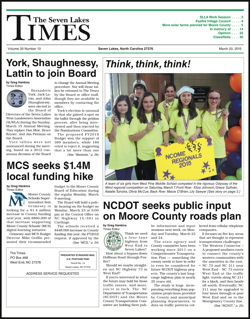 A proposal to add solar farms to the Moore County Zoning Ordinance was on the Thursday, March 7 agenda of the Moore County Planning Board, and it came just in the nick of time.
A proposal to add solar farms to the Moore County Zoning Ordinance was on the Thursday, March 7 agenda of the Moore County Planning Board, and it came just in the nick of time.
Three industrial-scale solar energy production facilities are in the works for Moore County -- two near the Montgomery County line and another on NC Highway 24/27 near Robbins. These solar farms use row-upon-row of photovoltaic cells stretched across dozens of acres of pastureland, capturing sunlight to make electricity, which is passed through an inverter and sold to power companies like Progress Energy or Randolph Electric Membership Corporation.
But, as Planner Jeremy Sparrow pointed out in introducing a proposed text amendment, the County's Zoning Ordinance doesn't currently provide for the development of solar collector facilities.
Three Solar Farms planned
Much as a new hospital in North Carolina must have the blessing of a state agency before expanding to add more beds, industrial scale energy producers must secure a Certificate of Public Convenience and Necessity from the NC Utilities Commission [NCUC] before getting into the power generation business.
Three companies planning solar farms in Moore County have filed the necessary paperwork with the Commission:
Samarcand Solar Farm, LLC is planning a 4.65 megawatt [MW] collection facility on a portion of a 200-acre tract on Samarcand Road, north of NC Highway 211. A filing with the NCUC indicates the project will cost $13.25 million and will have a design life of at least 25 years. The electricity will be sold to Progress Energy.
Spicewood Solar Farm, LLC is planning a similar facility nearby, on two tracts of land the lie between NC Highway 211 and the Perdue chicken feed plant, currently being used to grow turf grass. Spicewood's NCUC filing indicates that the 4.65 MW solar farm will occupy approximately 36 acres of the 47 acre parcel. Both the Samarcand and Spicewood facilities are working with solar provider Argand Energy Solutions of Charlotte.
Carthage Farm, LLC, working with Strata Solar of Chapel Hill, is planning a 7.0 MW solar farm on a 99 acre tract near the intersection of NC Highway 24/27 and Mount Carmel Road, Southeast of Robbins. They plan to sell power to the NC Electric Membership Corporations.
Sparrow told Planning Board members that the increased interest in solar power generating facilities is due in part to a law that the NC General Assembly adopted in 2007, requiring that electric public utilities increase their use of renewable energy from 3 percent of the power sold at retail to 12.5 percent by 2021. By 2018, 0.2% of power sold to retail customers must come from solar sources.
There are also attractive federal and state subsidies for the producers of solar and other renewable energy.
More information needed
Sparrow's proposed amendment to the Zoning Ordinance would allow solar farms as a conditional use in industrial and business zoning districts, as well as in the Rural Agricultural [RA] district.
He proposed a 50-foot setback from adjoining residential property, a 25 foot maximum height for the collectors (which are often mounted on poles), a six-foot perimeter fence, and vegetative screening from adjacent residential properties and public rights of way.
In addition, the recommended text amendments would require a performance bond or letter of credit to ensure that the equipment is removed by the operator once it has outlived its useful life.
Planning Board members expressed appreciation for the research and recommendations, but wanted significantly more information about solar farms before moving to approve the proposed text amendment.
"Could we have a company that does this for a business come speak to the basics?' Chairman Robert Hayter asked. "How do they select a site? How far from the grid do they have to be? The point is not for or against solar arrays, but making sure that what we do in terms of an ordinance is what's best for Moore County."
Board member Les Murray suggested that some members of the Board might visit a solar farm, and Ensminger said the planning staff could arrange a site visit for the entire Board. She also indicated that Argand Energy Solutions had expressed an interest in meeting with the Board.
"Lets have as much expertise and dialog as possible at the next meeting," Hayter said, referring to the April 4 Planning Board meeting. He asked Ensminger to identify nearby solar farms that Board members could visit on their own time.
Road Addressing Ordinance Approved
In other business during its March 7 meeting, the Planning Board approved a "Road Name and Addressing Ordinance," which will be forwarded onto the Board of Commissioners with a recommendation for approval.
Director Ensminger explained that the road naming and addressing function had shifted from the Planning Department to the GIS Department several years ago, but the ordinance itself had not been updated since 2000.
The new ordinance lays out standards for naming roads, changing road names, and assigning street numbers.
Two points of the proposed language met with resistance from Planning Board members, who amended the ordinance before forwarding it on to the Commissioners.
First, Chairman Hayter noted that the proposed ordinance would require that road names "use common spelling found in a standard dictionary."
"There is no such thing as a standard dictionary," he argued, suggesting that the ordinance name a specific dictionary, so that land planners (like Hayter) and developers would know which reference to use.
On a motion from Les Murray, the Board agreed to specify the latest edition of Webster's Dictionary as the authority for spellings.
Hayter and Murray -- as well as other Board members -- strongly objected to a clause in the proposed ordinance that said "Proper names of individuals or businesses are to be avoided."
GIS Programmer Rachel Wall explained that the department had recently dealt with a case in which a road had been named after one family that lived along it, but their property had been bought by another family. And now the new family wanted the road changed to their name.
But Hayer and others pointed out that naming highways, roads, and streets after people is so common as to be routine. Ultimately, the Board voted to strike that provision in the ordinance.
Finally, at Hayter's urging, the Board attached a recommendation to its approval of the ordinance that encourages the Commissioners to communicate the importance of the ordinance to the political leaders of all eleven Moore County municipalities.
Noting that the County names roads in the extraterritorial jurisdictions of the municipalities, but not inside the towns, Hayter said: "In my office we have had problems with that. There's not a smooth line in naming roads. You have to bring in the county to get the road named."
"I want to be absolutely sure that an intergovernmental effort at the political level is an effort we go through," he added. "It needs to be talked out at the executive level. If there is any way to make it work more smoothly, I would want to make that effort."
Work Sessions Planned
Planning Director Ensminger told the Board that she would like to schedule work sessions as part of the regular Board meeting whenever major text amendments -- like the solar farm amendment -- are to be proposed. The Board would have a work session on a major amendment one month and, perhaps, vote on it the following month.
Looking forward to the April 4 meeting, the staff will plan to present a straightforward text amendment on group homes, Ensminger said, and then hold a work session on solar farms.
In May, the Board will have a work session on a proposed revision to the sign ordinance.
Ensminger encouraged Planning Board members to attend a Moore County Transportation Committee workshop on Wednesday, March 13 and a Land Use Plan Steering Committee meeting on Monday, March 18.
